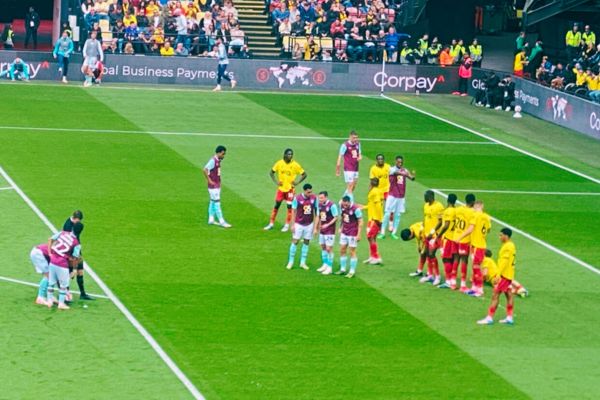Tweeeeet! The referee’s whistle pierces the air as he shouts, “Free-kick!” A foul has been awarded just 15 yards from goal. Immediately, a pack of players swarms the official—arguing, pleading, questioning. But the referee blocks out the noise. His focus is on the pitch.
He picks up the match ball and places it carefully at the spot of the foul. Then, without missing a beat, he reaches around his waist and unclips a small black can—the size of his palm. To the untrained eye, it might look like deodorant. But this isn’t about staying fresh—it’s about control.
He bends low and presses the nozzle. Out comes a white foam, sprayed in a neat semi-circle around the ball. Then he strides toward goal, counting silently: “…6, 7, 8, 9, 10.” Stopping precisely 10 yards from the ball, he sprays again—this time a bold line across the grass.
Turning back to the protesting players, he gestures to the line. “Stay behind that.” Arguments fade. A wall forms. The free-kick is ready.
What Is Referee Vanishing Spray?
Referee vanishing spray is a temporary, water-based foam used to enforce the 10-yard rule at free-kicks. It helps referees mark where the defensive wall must stand—and prevents players from creeping forward before the ball is kicked.

Where Did It Come From?
The spray was first used in South American football, particularly in Argentina and Brazil, where encroachment and delays were common during free-kick situations. The aim was simple: stop the creeping, reduce arguments, and speed up play.
Its success caught global attention, and by 2014, FIFA officially adopted vanishing spray at the World Cup in Brazil. It has remained a mainstay in top-level football ever since.
What’s It Made Of—and How Long Does It Last?
The spray typically contains a blend of water, butane, isobutane, and surfactants—a mixture that allows it to foam up when released, then vanish without damaging the pitch. Most lines disappear within 60–90 seconds, depending on weather and surface.
Has It Really Helped?

Yes—and no.
The referee vanishing spray has helped reduce encroachment and made it easier for referees to manage positioning. But it hasn’t stopped arguments altogether. Players still protest free-kick decisions. What the spray does offer, however, is a visual and psychological marker—something concrete in a game often filled with grey areas.
Football’s Newest Tech Meets the Oldest
Vanishing spray might be one of the newest tools in a referee’s arsenal. But what about the oldest? Curious about the bit of tech that's been around longer than anything else?
